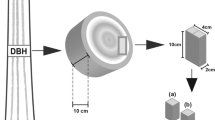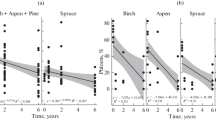Abstract
Fast-growing forest species established in tropical regions can supply much of the demand for renewable energy. The use of tree bark for energy is an alternative to gainfully exploit the residues generated by the forest industry. The aim of this study was to evaluate the potential of incorporation of bark in Schizolobium parahyba and Eucalyptus urophylla wood for energy purposes. The two species were planted with 3.0 m × 3.0 m spacing, in the central region of Brazil. The wood samples with and without bark were collected from trees, 3 years after planting to perform the physical and energy characterization of the biomass and the briquettes. The E. urophylla biomass presented better physical characteristics and lower ash content than S. parahyba. The presence of bark in E. urophylla and S. parahyba wood in small quantities (± 5%) is technically feasible for energy applications, including briquette production, thus offering an alternative for the destination of the residues produced in the wood processing industry.
Similar content being viewed by others
References
Stanturf JA, Vance ED, Fox TR, Kirst M (2013) Eucalyptus beyond its native range: environmental issues in exotic bioenergy plantations. Int J For Res 1:1–5. https://doi.org/10.1155/2013/463030
Jagger P, Kittner N (2017) Deforestation and biomass fuel dynamics in Uganda. Biomass Bioenergy 105:1–9. https://doi.org/10.1016/j.biombioe.2017.06.005
Eufrade Junior HJ, Nakashima GT, Yamaji FM, Guerra SPS, Ballarin AW (2017) Eucalyptus short-rotation coppice for solid fuel production. Ind Crop Prod 108:636–640. https://doi.org/10.1016/j.indcrop.2017.07.025
Goncalves B, Till D, Fasina O, Tamang B, Gallagher T (2015) Influence of bark on the physical and thermal decomposition properties of short-rotation Eucalyptus. BioEnergy Research 8:1414–1423. https://doi.org/10.1007/s12155-015-9606-1
Mason PE, Darvell LI, Jones JM, Pourkashanian M, Williams A (2015) Single particle flame-combustion studies on solid biomass fuels. 151:21–30. https://doi.org/10.1016/j.fuel.2014.11.088
Resende MDV, Resende JRMFR, Sansaloni CP, Petroli CD, Missiaggia AA, Aguiar AM, Abad JM, Takahashi EK, Rosado AM, Faria DA, Pappas JRGJ, Kilian A, Grattapaglia D (2012) Genomic selection for growth and wood quality in Eucalyptus: capturing the missing heritability and accelerating breeding for complex traits in forest trees. New Phytol 194:116–128. https://doi.org/10.1111/j.1469-8137.2011.04038.x
Corrêa TR, Picoli EAT, Souza GA, Condé SA, Silva NM, Lopes-Mattos KLB, Resende MDV, Zauza EAV, Oda S (2017) Phenotypic markers in early selection for tolerance to die back in Eucalyptus. Ind Crop Prod 107:130–138. https://doi.org/10.1016/j.indcrop.2017.05.032
Brasil Indústria Brasileira De Árvores (2017) Relatório 2017. São Paulo
Binkley D, Campoe OC, Alvares C, Carneiro RL, Cegatta I, Stape JL (2017) The interactions of climate, spacing and genetics on clonal Eucalyptus plantations across Brazil and Uruguay. For Ecol Manag 405:271–283. https://doi.org/10.1016/j.foreco.2017.09.050
Lahr FAR, Nogueira MCJA, Araujo VA, Vasconcelos JS, Christoforo AL (2017) Physical-mechanical characterization of Eucalyptus urophylla wood. Journal of The Brazilian Association of Agricultural Engineering 37:900–906. https://doi.org/10.1590/1809-4430-eng.agric.v37n5p900-906/2017
Cordeiro IMCC, Barros PLC, Lameira OA, Gazel Filho AB (2015) Avaliação de plantios de paricá (Schizolobium parahyba var. amazonicum (Huber ex Ducke) Barneby de diferentes idades e sistemas de cultivo no município de Aurora do Pará - PA (Brasil). Ciência Florestal 25:679–687. https://doi.org/10.5902/1980509819618
Rosa LS (2006) Características botânicas, anatômicas e tecnológicas do Paricá (Schizolobium amazonicum Huberr ex Ducke). Revista de Ciências Agrárias 46:63–79
Nisgoski S, Muñiz GIB, Trianoski R, Matos JLM, Venson I (2012) Características anatômicas da madeira e índices de resistência do papel de Schizolobium parahyba (Vell.) Blake proveniente de plantio experimental. Scientia Forestalis 40:203–211
Coneglian A, Ribeiro PHP, Melo BS, Pereira RF, Dorneles Junior J (2016) Initial growth of Schizolobium parahybae in Brazilian Cerrado soil under limingand mineral fertilization. Revista Brasileira de Engenharia Agrícola e Ambiental 20:908–912. https://doi.org/10.1590/1807-1929/agriambi.v20n10p908-912
Oliveira CM (2016) Biomassa Bioenergia Briquetes Woodpellets. 1st ed. Electronic Version. Curitiba
McIntosh S, Vancov T, Palmer J, Spain M (2012) Ethanol production from Eucalyptus plantation thinnings. Bioresour Technol 110:264–272. https://doi.org/10.1016/j.biortech.2012.01.114
Moore JR, Cown DJ (2015) Processing of wood for wood composites. Wood Composites:27–45. https://doi.org/10.1016/B978-1-78242-454-3.00002-0
Rosdiana NA, Dumarçay S, Gérardin C, Chapuis H, Santiago-Medina FJ, Sari RK, Syafii W, Gelhaye E, Aharivelomanana P, Mohammed R, Gérardin F (2017) Characterization of bark extractives of different industrial Indonesian wood species for potential valorization. Ind Crop Prod 108:121–127. https://doi.org/10.1016/j.indcrop.2017.06.034
Castro AFNM, Castro RVO, Carneiro ACO, Carvalho AMML (2016) Correlations between age, wood quality and charcoal quality of eucalyptus clones. Revista Árvore 40:551–560. https://doi.org/10.1590/0100-67622016000300019
Reina L, Botto E, Mantero C, Moyna P, Menéndez P (2016) Production of second generation ethanol using Eucalyptus dunnii bark residues and ionic liquid pretreatment. Biomass Bioenergy 93:116–121. https://doi.org/10.1016/j.biombioe.2016.06.023
Ben H, Hao N, Liu Q, Ragauskas AJ (2017) Solid-state NMR investigation of bio-chars produced from biomass components and whole biomasses. 10:1036–1044. https://doi.org/10.1007/s12155-017-9863-2
Wang L, Barta-Rajnai E, Skreiberg Ø, Khalil R, Czégény Z, Jakab E, Barta Z, Grønli M (2017) Effect of torrefaction on physiochemical characteristics and grindability of stem wood, stump and bark. Appl Energy In press. https://doi.org/10.1016/j.apenergy.2017.07.024
Neiva DM, Araújo S, Gominho J, Carneiro AC, Pereira H (2018) An integrated characterization of Picea abies industrial bark regarding chemical composition, thermal properties and poler extracts activity. PLoS One 13:1–14. https://doi.org/10.1371/journal.pone.0208270
Sette CR Jr, Hansted ALS, Novaes E, Lima PAF, Rodrigues AC, Santos DR, Yamaji FM (2018) Energy enhancement of the eucalyptus bark by briquette production. Ind Crop Prod 122:209–213. https://doi.org/10.1016/j.indcrop.2018.05.057
Hansted ALS, Cacuro TA, Nakashima GT, Costa VE, Yamamoto H, Yamaji FM (2018) Use of a lignocellulosic residue as solid fuel: the effect of ash content in the energy potential. Ind Crop Prod 116:209–214. https://doi.org/10.1016/j.indcrop.2018.02.042
Arteaga-Pérez LE, Segura C, Bustamante-García V, Cápiro OG, Jiménez R (2015) Torrefaction of wood and bark from Eucalyptus globulus and Eucalyptus nitens: focus on volatile evolution vs feasible temperatures. Energy. 93:1731–1741. https://doi.org/10.1016/j.energy.2015.10.007
Alvares CA, Stape JL, Sentelhas PC, Gonçalves JLM, Sparovek G (2014) Köppen’s climate classificatiom map for Brazil. Meteorol Z 22:711–728. https://doi.org/10.1127/0941-2948/2013/0507
Perez DV (2013) Sistema brasileiro de classificação de solos, 3rd edn. Embrapa Solos, Brasília
ABNT NBR 11941 (2003) Standard practice for wood - determination of basic density. ABNT 2003. http://www.abntcatalogo.com.br
ASTM E872 (1982) Standard test methods for volatile matter in the analysis of particulate wood fuels. www.astm.org
ASTM D1102 (1984) Standard test methods for ash in wood. www.astm.org
ASTM D5865 (2013) Standard test methods for gross calorific value of coal and coke. www.astm.org
Sartori MMP, Florentino HO, Basta C, Leão AL (2001) Determination of the optimal quantity of crop residues for energy in sugarcane crop management using linear programming in variety selection and planting strategy. Energy. 26:1031–1040. https://doi.org/10.1016/S0360-5442(01)00052-4
ASTM D5057 (2017) Standard test method for screening apparent specific gravity and bulk density of waste. www.astm.org
Toscano G, Riva G, Pedretti EF, Corinaldesi F, Mengarelli C, Duca D (2013) Investigation on wood pellet quality and relationship between ash content and the most important chemical elements. Biomass Bioenergy 56:317–322. https://doi.org/10.1016/j.biombioe.2013.05.012
Liu ZJ, Fei BH, Jiang ZH, Cai ZY, Liu XE (2014) Important properties of bamboo pellets to be used as commercial solid fuel in China. Wood Sci Technol 48:903–917. https://doi.org/10.1007/s00226-014-0648-x
Protásio TP, Alves ICN, Trugilho PF, Silva VO, Baliza AER (2011) Compactação de biomassa vegetal visando a produção de biocombustíveis sólidos. Pesquisa Florestal Brasileira 31:273–283. https://doi.org/10.4336/2011.pfb.31.68.273
Narita DK, Nakashima GT, Roz AL, Pires AAF, Yamaji FM (2018) uso do guapuruvu (Schizolobium parahyba) para fins energéticos. Ciência Florestal 28:758–764. https://doi.org/10.5902/1980509832089
Magdziarz A, Gajek M, Nowak-Wozny D, Wilk M (2017) Mineral phase transformation of biomass ashes e experimental and thermochemical calculations. Renew Energy 128:446–459. https://doi.org/10.1016/j.renene.2017.05.057
Alonso MZ, Tran K, Wang L, Skreiberg Ø (2017) A kinetic study on simultaneously boosting the mass and fixed-carbon yield of charcoal production via atmospheric carbonization. Energy Procedia 120:333–340. https://doi.org/10.1016/j.egypro.2017.07.216
Sette CR Jr, Freitas PC, Freitas VP, Yamaji FM, Almeida RA (2016) Production and characterization of bamboo pellets. Biosci J 32:922–930. https://doi.org/10.14393/BJ-v32n4a2016-32948
Freitas AJ, Costa ACS, Oliveira AC, Pereira BLC, Rocha MFV, Carneiro ACO (2016) Efeito da pressão e do tempo de compactação nas propriedades de briquetes de resíduos madeireiros de Paricá. Nativa 4:380–385. https://doi.org/10.14583/2318-7670.v04n06a06
Seixas F, Bauch SC, Oliveira Junior ED (2005) Energetic balance and economical study of two debarking alternatives for Eucalyptus wood. Scientia Forestalis 67:37–43
Rodrigues PMM, Coneglian A, Silva MF, Moraes MDA, Sette Junior CR (2018) Characterization of Schizolobium parahyba (Vell.) S.F. Blake and Eucalyptus urophylla S.T. Blake juvenile wood in Brazilian savanna soil. Revista de Ciências Agrárias 41:253–261
Ogut F, Maltecca C, Whetten R, Mckeand S, Isik F (2014) Genetic analysis of diallel progeny test data using factor analytic linear mixed models. For Sci 60:119–127. https://doi.org/10.5849/forsci.12-108
Andrade AM, Carvalho LM (1998) Potencialidades energéticas de oito espécies florestais do estado do Rio de Janeiro. Floresta e Ambiente 5:24–42
Pereira BLC, Carneiro ACO, Carvalho AMML, Vital BR, Oliveira AC, Canal WD (2016b) Influência da adição de lignina kraft nas propriedades de pellets de eucalipto. Floresta. 46:235–242. https://doi.org/10.5380/rf.v46i2.44936
Bibbiani C, Fantozzi F, Gargari C, Campiotti CA, Schettini E, Vix G (2016) Wood biomass as sustainable energy for greenhouses heating in Italy. Agriculture and Agricultural Science Procedia 8:637–645. https://doi.org/10.1016/j.aaspro.2016.02.086
Hansted ALS, Nakashima GT, Martins MP, Yanamoto H, Yamaji FM (2016) Comparative analyses of fast growing species in different moisture content for high quality solid fuel production. Fuel 184:180–184
Furtado TS, Ferreira JC, Brand MA, Neves MD (2012) Correlação entre teor de umidade e eficiência energética de resíduos de Pinus taeda em diferentes idades. Revista Árvore 36:577–582. https://doi.org/10.1590/S0100-67622012000300020
Araújo S, Vilas Boas MA, Neiva DM, Carneiro AC, Vital B, Breguez M, Pereira H (2016) Effect of a mild torrefaction for production of eucalypt wood briquettes under different compression pressures. Biomass Bioenergy 90:181–186. https://doi.org/10.1016/j.biombioe.2016.04.007
Vega LY, Lopez L, Valdés CF, Chejne F (2019) Assessment of energy potential of wood industry wastes through thermochemical conversions. Waste Manag 87:108–118. https://doi.org/10.1016/j.wasman.2019.01.048
Author information
Authors and Affiliations
Corresponding author
Additional information
Publisher’s Note
Springer Nature remains neutral with regard to jurisdictional claims in published maps and institutional affiliations.
Rights and permissions
About this article
Cite this article
Sette Jr, C.R., da Cunha, T.Q.G., Coneglian, A. et al. Does the Presence of Bark in the Wood of Fast-Growing Forest Species Significantly Change the Energy Potential?. Bioenerg. Res. 13, 222–228 (2020). https://doi.org/10.1007/s12155-020-10115-w
Published:
Issue Date:
DOI: https://doi.org/10.1007/s12155-020-10115-w




